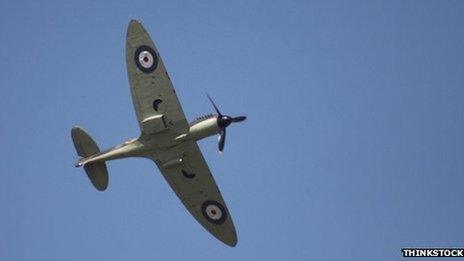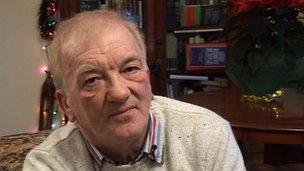WWII Spitfires digging team leaves for Burma
- Published

Mr Cundall said the Spitfire was a very special aeroplane
A team of experts is heading to Burma for the final stage of a 17-year search to locate a hoard of Spitfire planes.
The group of 21, led by North Lincolnshire farmer David Cundall, is expected to to begin digging at Yangon International Airport.
Mr Cundall, who first heard stories of the buried planes in 1996, said: "We think we have found them."
Scientists and archaeologists including staff from Leeds University will join Mr Cundall on the expedition.
Mr Cundall said he hoped to restore any planes found by the team to flying condition in the UK.
He believes a large number of brand new Mark XIV Spitfires were buried in wooden crates on the orders of Lord Mountbatten during August and December 1945 as "surplus to requirements" at the end of World War II, said Mr Cundall.
'Easily restorable'
Before flying out to Burma, he said the finds could be on the "same level as the Tutankhamun find in Egypt".

Mr Cundall has been searching for crashed aircraft for 36 years
There could be up to 36 buried planes at the end of the airport's runway in Mingaladon and up to 124 aircraft in total, it is thought.
Mr Cundall said he expected the search to include three different airfields and to last about six weeks.
He said: "They'll be in a very good condition. If they haven't been damaged they should be easily restorable to flying condition."
Mr Cundall has been searching for, and digging up, crashed aircraft for 36 years.
In 2004, he conducted an electromagnetic survey of the site with the help of Dr Adam Booth, then of the University of Leeds, along with a further ground-penetrating radar survey.
Dr Booth, of Imperial College London, is still involved in the search for the planes.
Battle of Britain
The excavation team will also include war veteran Stanley Coombe, from Eastbourne, who responded to Mr Cundall's appeal for witnesses who saw them being buried 68 years ago.
Mr Coombe, who is now in his early 90s, was stationed in Burma at the end of World War II and is one of eight eye-witnesses to come forward.
It took Mr Cundall a further eight years following the electromagnetic survey, to sign an actual contract to start digging for the planes.
The contract allows the dig to go ahead and would see the Burmese government take 50% of the value of aircraft recovered, while Mr Cundall's share will be 30% and his agent 20%.
Mr Cundall said: "It's about preserving aeroplanes. The Spitfire was a very special aeroplane, it saved our neck in 1940 in the Battle of Britain.
"Built as a tool of war I am hoping to use them as a tool of friendship to bring Burma and Great Britain closer together."
- Published31 December 2012
- Published28 November 2012